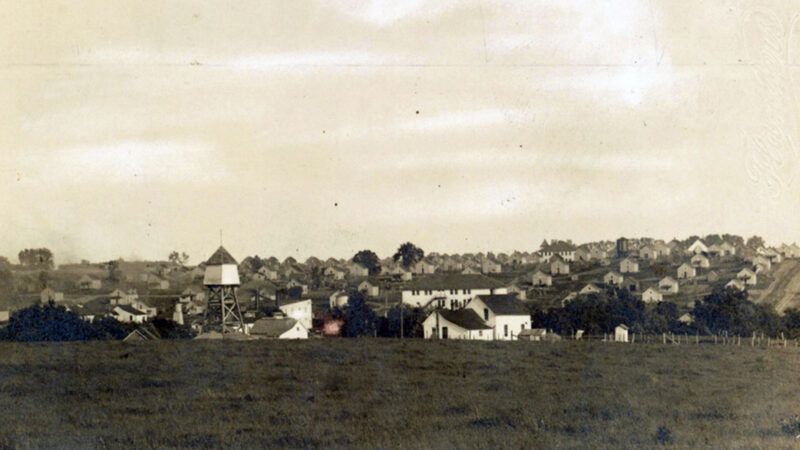This Company Coal Town in Iowa Was a 'Black Utopia'
It was integrated, it was unionized—and it was a company town.

More than a century ago, there was a town where families of different races lived side by side. Neither housing nor schooling was segregated, and blacks and whites received the same wages for the same work. They also enjoyed many appealing amenities, from high-quality homes to a three-story YMCA. When the historian Dorothy Schwieder and the sociologists Elmer Schwieder and Joseph Hraba interviewed dozens of former residents for their 1987 book Buxton, the old-timers' memories were positively glowing. One African-American woman remembered the place as a "kind of heaven."
That is not a phrase one ordinarily associates with a coal-mining company town. But Buxton, Iowa, was built by the Consolidation Coal Company.
Company towns are supposed to be the most predatory sort of proprietary communities: micro-dystopias where debt-ridden workers are forced to shop at a monopolistic company store. Even in the more benevolent settlements where so-called welfare capitalism held sway—in, say, the chocolate magnate Milton Hershey's model town of Hershey, Pennsylvania, with its free schools and company-funded public transportation—there were strong overtones of paternalism. And, often, a hope that such amenities would keep workers from organizing for better conditions on their own terms.
That image was always exaggerated: While abusive company towns undeniably existed, the economic historian Price Fishback made a strong case in 1992's Soft Coal, Hard Choices that the abuses were limited by a sometimes-intense competition for workers. But in Buxton, the company store didn't even try to maintain a monopoly: The locals were free to compete with it, and many launched businesses that did. And the amenities weren't there to lure miners away from unions, because the miners were unionized from the start.
***
The Buxton saga begins with another Iowa company town, called Muchakinock. Coal companies often recruited black workers as strikebreakers, and in 1880 Consolidation started bringing black Virginians to Muchakinock for exactly that purpose. They proved to be good employees, and the company kept recruiting African-American workers after the labor strife died down.
It wasn't unusual that competition for labor would benefit black miners. Fishback notes, for example, that coal companies eager to attract African-American employees made an effort to "reduce the inequality of the West Virginia segregated school system." But Muchakinock offered an unusually high level of racial equality. An unincorporated community formed around the settlement, with independent black businesses and a mutual aid society, called The Colony, that adjudicated disputes and helped pay miners' medical expenses.
When the mines were nearly depleted, the company moved many workers to a new spot in nearby Monroe County. There, in 1900, Buxton was born. Here the black employees were not strikebreakers: The mines were unionized, with a contract that covered both black and white workers. Another unincorporated community grew, with churches, shops, newspapers, hotels, and secret societies. By 1905, independent historian Rachelle Chase wrote in Creating the Black Utopia of Buxton, Iowa, it was "a town of 5,000 where 55 percent of the population was black." The typical Iowa coal town was much smaller, and the typical Iowa town of any sort was overwhelmingly white.
So why did it die? Because even a voluntaristic order can be too centralized. As long as the town depended on one company—and one finite resource—it wasn't built to last.
Buxton was built around a single industry. That had many effects, including a social gap between the people who ran the mines and everyone else. (When Hraba and the Schwieders interviewed one superintendent's daughter, they found that she didn't even realize how integrated Buxton had been. Her family had stuck to socializing with the other managers' families, and she never visited the company store.) Most importantly, it meant the town's fortunes were bound up with the company's fortunes.
As the mines at Buxton were depleted, Consolidation started opening new settlements—Consol in 1914, Haydock in 1918—and transferring workers away from Buxton. As the reason for the town evaporated, so did the town; by 1922 it was abandoned. Then the industry itself hit some lean years, and coal camps started shuttering across the state. Consolidation itself fell on hard times, and an Illinois company absorbed it in 1925.
Let Buxton be both an inspiration and a cautionary tale. This lost Iowa town shows how market forces can improve living standards and foster social tolerance. But it offers an important reminder too: If you want a community to last, don't put all its eggs in one basket.
This article originally appeared in print under the headline "The Life and Death of a Company Town."
Show Comments (35)